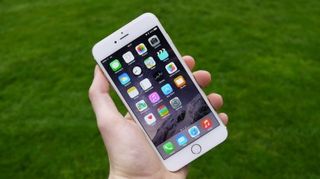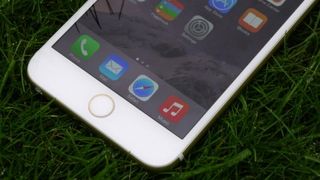Update: We have revisited the iPhone 6 Plus, which is now packed with iOS 10, and fully updated our review to reflect the new features and lower price.
You'll also find comparisons of Apple's first plus-sized with its latest, the iPhone 7 Plus. As you might expect, a lot has changed - but there's a lot that hasn't, too.
Original review follows below.
A 5.5-inch iPhone. That might not seem so unusual now, but when it first appeared it was something which would have sent a shudder down the spines of a collective of die-hard Apple fans, as it was a handset some thought we'd never see from the Cupertino-based outfit.
Yet here I am, staring down the barrel of what was once the biggest iPhone in history – the iPhone 6 Plus.
It arrived alongside the iPhone 6 – Apple's 2014 flagship smartphone – which measures 4.7 inches, making it more welcoming to a wider array of palms than the supersized iPhone 6 Plus.
Many of you, especially those of an Android persuasion, may be wondering what all the fuss is about – after all, the Samsung Galaxy Note 2 turned up with a 5.5-inch display years ago.
- Compare: all the best iPhone 6 Plus deals
Take a moment to glance at the history of the iPhone though, and you'll see why the iPhone 6 Plus was such a big deal.
Previously Apple has only dealt in two screen sizes: a 3.5-inch display graced the first five generations of iPhone, and just three have had the pleasure of a larger 4-inch display.

5.5 inches then is a huge leap forward for Apple, moving its iPhone range into the uncharted waters of the phablet market currently dominated by Samsung and other Android manufacturers.
It's less impressive now, with the launch of the iPhone 6S and iPhone 6S Plus(and even more recently, with the iPhone 7 and iPhone 7 Plus) reinforcing Apple's commitment to the larger screen sizes.
Apple is looking to reach a previously untapped audience of smartphone users – those who demand a large screen – with 'productivity' the main buzzword being thrown around. A key market for the iPhone 6 Plus is Asia, where the general consensus seems to be bigger is better when it comes to smartphone screens.
In terms of specs and design, there isn't a huge amount of difference between the iPhone 6 Plus and the iPhone 6, apart from the obvious size.

The iPhone 6 Plus does boast a couple of unique features however. It was the first iPhone to pack a full HD display, plus its bigger body means it houses a larger battery than its 4.7-inch brother.
Both sport A8 64-bit processors, 1GB of RAM, M8 motion coprocessors and 8MP rear-facing cameras – although the snapper on the iPhone 6 Plus benefits from OIS (optical image stabilisation), while the iPhone 6 makes do with EIS (electronic image stabilisation). This is a much smaller difference than we see in today's batch of iPhones, with the iPhone 7 Plus sporting a dual-camera setup.

iPhone 6 Plus price
As with all Apple products, the iPhone 6 Plus didn't come cheap at launch, but you can expect to find it much more affordable today.
The iPhone 6 Plus is no longer offered on the Apple Store, pushed out by the iPhone 7. However, the last we saw it, the SIM-free 16GB version was priced alongside the iPhone 6S and iPhone 6S Plus at US$649 (£539, AU$1,079) – and that's just the start.
Apple ditched the 32GB variant for both the iPhone 6 and iPhone 6 Plus long ago, so if you're searching for one, you'll probably have better luck finding the 64GB variant in the wild, which we last saw going for $749 (£619, AU$1229) from Apple.
There was also a 128GB model, but that's been discontinued, so if you need a boatload of storage you'll have to opt for the newer iPhone 6S Plus or iPhone 7 Plus.

Even with some price drops, the Apple iPhone 6 Plus will probably be around the same, if not a little more expensive than rival phablets including the LG G5, OnePlus 3, Nexus 6P and Samsung Galaxy Note 4.
It's big, it's expensive and it's inevitably played second fiddle to the iPhone 6 – so is the iPhone 6 Plus worth considering? Read on to find out.






















